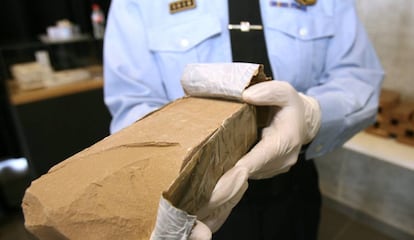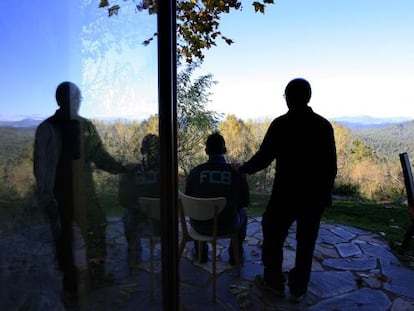Why heroin is threatening to make a comeback in Spain
The sinister return of this drug exposes Holland as Europe’s main drug supermarket

For decades it was known as “caballo,” or horse, and it inspired a plethora of metaphors. In the 1980s, it plagued a generation of Spaniards, and tore families apart in an epidemic that gradually lost momentum. Recently, however, the threat of widespread heroin consumption is once again hanging over Spain. And while user numbers have remained stable, laboratories have been dismantled for the first time ever in Valladolid and Cuenca, with police seizing 56 kilograms in April in Tui, Galicia; 27 kilograms between A Coruña and Portugal in December 2015; and another 16 kilograms in July 2015 from the Arosa River. This year alone 256 kilograms of heroin has been confiscated by police, 12 kilograms more than last year. So where is it all coming from?
This year alone 256 kilograms of heroin has been confiscated by police, 12 kilograms more than last year
During the presentation of its annual report at the end of May in Lisbon, the EU Drugs Agency (EMCDDA) warned of the dangers of a domino effect triggered by the flood of heroin from Afghanistan and spoke of a rise in deaths from overdoses. ”It is not clear whether these phenomena are related but it’s worth investigating,” the report said.
Just when heroin was beginning to seem like a drug of the past, associated with the ravages of AIDS, all the signs point to a potential resurgence. “Although there are no data suggesting a rise in consumption, heroin is starting to be used as a relaxant, to counteract the effects of more stimulating drugs such as cocaine,” says drug squad chief José Ramon Noreña. It’s a view backed by anti-drug associations in Galicia.
Profile of a Modern Junkie
The modern junkie may inhabit an underground world but he has little to do with 1980s addict, according to experts.
He or she is a young person oblivious to what happened in the 1980s. They don't inject the drug, they smoke it, so they don't associate it with the risk of AIDS. Often they take it to alleviate the effects of other drugs like cocaine or ecstasy. It is seen as a quick way to chill out.
Basically, the glut of heroin is to do with the laws of supply and demand. “Since the Americans and the blue berets left Afghanistan, the number of poppy plantations has rocketed, as has production,” says the Chief of the Central Narcotics Squad. “It is coming into Europe through Turkey. The Turks are great businessmen and they have an incredible network of contacts at their disposal.”
According to the police, it is these groups of Turkish “businessmen” who smuggle the drug in and out of Rotterdam. “There are a lot of Turkish immigrants living around the port. They are the ones who store and market the drugs. Right now there is unsold stock so it is extremely cheap,” says one officer, who calculates that a kilo of heroin worth €20,000 can bring in €10,000 profit just for transporting it.
“It’s all organized from Holland and if there are investigations, that is where they hit a wall,” says Judge José Antonio Vazquez Tain, who is well known for his role in the war on drugs. “Their methods are not effective in dealing with organized crime. Now they also have a problem with Islamic terrorism but they don’t realize it.”
The only controls smugglers run up against are in France because of the Jihadi terrorism threat
Experts agree that the Dutch don’t see drugs as a priority. “In Spain we are much more proactive,” says Noreña. “It’s as though they were blind to them.”
Heroin reaches Spain in the false bottoms of trucks or simply tucked away in smaller vehicles. “It’s easier to smuggle because the quantities are small,” says another drug squad officer. “We’re not talking about big containers like they need for cocaine. The only controls they run up against are in France because of the Jihadi terrorism threat, otherwise they come and go from Holland as they please.”
Galicia is one of the biggest destinations for heroin, along with Barcelona, Madrid and Zaragoza. The networks have long been established and its border with Portugal makes it challenging territory to police. “They have recently discovered groups from Albania and Kosovo who are distributing it on both sides of the frontier, from Tui and Porriño to Portugal,” says a drug squad boss in Galicia.
Many of the drug families are coming out of jail now and getting back to work, making use of the new contacts they have made in prison. They’re always on the job
According to a police chief in Pontevedra, “They even use the neighboring Portuguese towns to store the stuff because they know that although there is a good understanding between the Spanish and Portuguese police, the border makes investigations more difficult.”
In Galicia, the drug trade is run by the same crowd as always. They go about their business under the indifferent gaze of the locals who frequent their stores and bars. “The big drug families are still in business,” says one of the directors of the Special Response Group Against Organized Crime (GRECO) in Galicia. “Many of them are coming out of jail now and getting back to work, making use of the new contacts they have made in prison. They’re always on the job,” he jokes.
English version by Heather Galloway.
Tu suscripción se está usando en otro dispositivo
¿Quieres añadir otro usuario a tu suscripción?
Si continúas leyendo en este dispositivo, no se podrá leer en el otro.
FlechaTu suscripción se está usando en otro dispositivo y solo puedes acceder a EL PAÍS desde un dispositivo a la vez.
Si quieres compartir tu cuenta, cambia tu suscripción a la modalidad Premium, así podrás añadir otro usuario. Cada uno accederá con su propia cuenta de email, lo que os permitirá personalizar vuestra experiencia en EL PAÍS.
¿Tienes una suscripción de empresa? Accede aquí para contratar más cuentas.
En el caso de no saber quién está usando tu cuenta, te recomendamos cambiar tu contraseña aquí.
Si decides continuar compartiendo tu cuenta, este mensaje se mostrará en tu dispositivo y en el de la otra persona que está usando tu cuenta de forma indefinida, afectando a tu experiencia de lectura. Puedes consultar aquí los términos y condiciones de la suscripción digital.
More information
Últimas noticias
There is as much life left to discover on planet Earth as that which is already known
Dozens presumed dead, around 100 injured in fire at Swiss Alps bar during New Year’s celebration
Is porn for women different from conventional porn? We spoke to those who make it
Cartagena de Indias is sinking: What can the city do to mitigate it?
Most viewed
- David King, chemist: ‘There are scientists studying how to cool the planet; nobody should stop these experiments from happening’
- Reinhard Genzel, Nobel laureate in physics: ‘One-minute videos will never give you the truth’
- Oona Chaplin: ‘I told James Cameron that I was living in a treehouse and starting a permaculture project with a friend’
- Sinaloa Cartel war is taking its toll on Los Chapitos
- The Interoceanic Train, the Mexican alternative to the Panama Canal










































